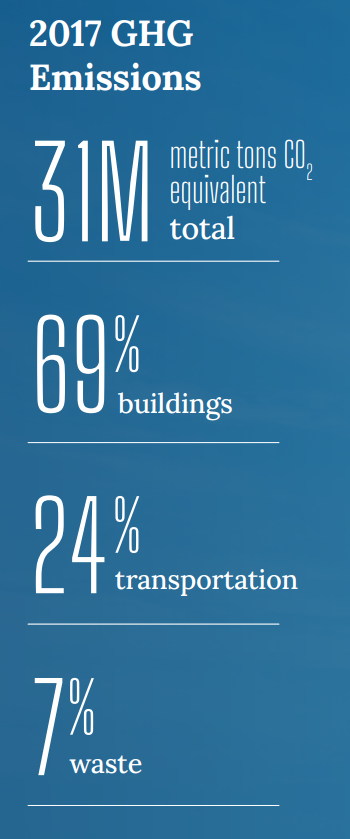Electrify Chicago
An independent tool for viewing City of Chicago building data
According to the
2022 Chicago Climate Action Plan,
69% of Chicago's emissions come from buildings, making
building emissions our biggest challenge and our biggest opportunity as a city
to tackle climate change. At Electrify Chicago, we showcase building performance using
publicly available data supplemented by community-submitted photographs and building
owners.
Start by looking at Chicago's buildings with the highest greenhouse gas intensity i.e. emissions per square foot. Large, efficient, buildings can perform much better than very inefficient small buildings on this metric.
New Article
📰 $30 Million In Missed Fines
The City Of Chicago failed to collect $30 million in potential fines from the building benchmarking ordinance, reducing transparency and accountability.
Legislative update! 🎉
As of late January 2024, legislation is being introduced to require new use more efficient forms of water and space heating, via the Clean And Affordable Buildings Ordinance (CABO), which will reduce the number of highly polluting and inefficient buildings that end up on this site.
If you're in Chicago,
write to your alderman to support the CABO!
Chicago Buildings by Greenhouse Gas Intensity
Note: Data includes large Chicago buildings with data from 2022, unless explicitly stated otherwise.
Note: This data only includes buildings whose emissions are reported
under the
Chicago Energy Benchmarking Ordinance. According to the City “As of 2016,
this list includes all commercial, institutional, and residential buildings larger than
50,000 square feet.” This dataset is also then filtered to only buildings with
reported emissions > 1,000 metric tons CO2 equivalent.
The latest year of data is from 2022, but we update the site regularly when new data is available, and some buildings may have failed to report that year, and only have older data available.
| Property Name / address | Primary Property Type |
Greenhouse Gas Intensity (kg CO2 eq./sqft) |
Total Greenhouse Emissions (metric tons CO2 eq.) |
|---|---|---|---|
|
1420 N Lake Shore Dr
1420 N Lake Shore Dr
| Multifamily Housing | 5.5 kg/sqft
Lowest 33%
| 901 tons
Highest 49%
|
|
Schubert -CPS
(CPS)
2727 N Long Ave
| K-12 School | 5.5 kg/sqft
Lowest 33%
| 554 tons
Lowest 30%
|
|
Sauganash Elementary -CPS
(CPS)
6040 N Kilpatric Ave
| K-12 School | 5.5 kg/sqft
Lowest 33%
| 377 tons
Lowest 15%
|
|
Northwest Middle School
🕰️
(CPS)
2250 N Latrobe Ave
| K-12 School | 5.5 kg/sqft | 651 tons |
|
Locke Elementary -CPS
(CPS)
2845 N Newcastle Ave
| K-12 School | 5.5 kg/sqft
Lowest 33%
| 664 tons
Lowest 38%
|
|
Prussing Elementary, Ernst -CPS
(CPS)
4650 N Menard Ave
| K-12 School | 5.5 kg/sqft
Lowest 33%
| 559 tons
Lowest 31%
|
|
Hamilton Elementary, Alexander - CPS
(CPS)
1650 W Cornelia Ave
| K-12 School | 5.5 kg/sqft
Lowest 33%
| 407 tons
Lowest 17%
|
|
Brown Elementary, William H -CPS
🕰️
(CPS)
54 N Hermitage Ave
| K-12 School | 5.5 kg/sqft | 347 tons |
|
Mt Greenwood Elementary -CPS
(CPS)
10841 S Homan Ave
| K-12 School | 5.5 kg/sqft
Lowest 33%
| 645 tons
Lowest 37%
|
|
Ashburn Community Elementary -CPS
(CPS)
8300 S St Louis Ave
| K-12 School | 5.5 kg/sqft
Lowest 33%
| 320 tons
Lowest 10%
|
|
3180 Condominium Association
3180 N Lake Shore Dr
| Multifamily Housing | 5.5 kg/sqft
Lowest 33%
| 1,917 tons
Highest 24%
|
|
Century Tower
182 W Lake St
| Multifamily Housing | 5.5 kg/sqft
Lowest 33%
| 1,415 tons
Highest 34%
|
|
Irene McCoy Gaines Apartments
3700 W Congress Pkwy
| Multifamily Housing | 5.5 kg/sqft
Lowest 33%
| 649 tons
Lowest 37%
|
|
Michigan Avenue Tower Condominium Association
1250 S Michigan Ave
| Multifamily Housing | 5.5 kg/sqft
Lowest 33%
| 2,223 tons
Highest 20%
|
|
900/910 Lake Shore Drive
900 N Lake Shore Dr
| Multifamily Housing | 5.5 kg/sqft
Lowest 33%
| 3,423 tons
Highest 11%
|
Data Source:
Chicago Energy Benchmarking Data
